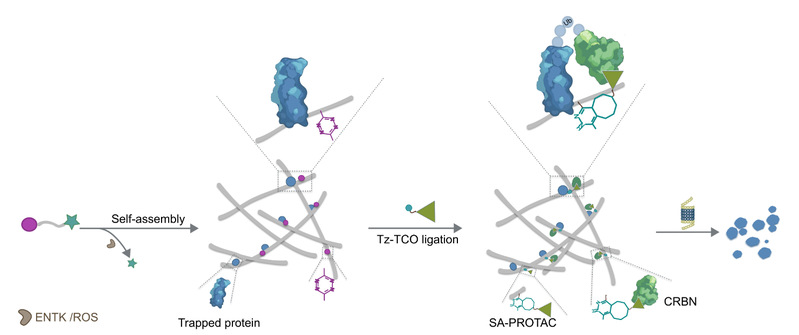Recently, Professor Yuan Gao from the School of Materials Science and Engineering at Beijing University of Chemical Technology published a study entitled “In situ construction of intracellular supramolecular assemblies as an alternative strategy for protein degradation” in the internationally renowned journal Nature Communications. The research demonstrates that interactions between in situ-formed intracellular supramolecular assemblies and specific endogenous proteins can induce proximity effects with subsequently recruited ubiquitin-proteasome systems, successfully achieving ligand-free protein degradation.
As central executors of life activities, abnormal accumulation of proteins can lead to diseases such as cancer. Current targeted protein degradation technologies (e.g., PROTACs) rely on bifunctional molecular connectors to link target proteins with degradation systems. However, these methods face two major limitations: first, the need to screen high-affinity small-molecule ligands for each target protein; second, poor cell permeability and limited efficacy due to large molecular sizes. Notably, approximately 80% of global proteins remain difficult to degrade with existing strategies due to the lack of identifiable ligands, posing a critical challenge in the field. Inspired by spontaneously formed supramolecular structures in biological systems, the research team innovatively developed a ligand-free protein capture technology. By designing tumor microenvironment-responsive supramolecular assembly precursors, they constructed nanofibrous supramolecular self-assemblies intracellularly in cancer cells, effectively capturing histone H2B or Cofilin-2. Combined with bioorthogonal chemistry, this approach enabled selective degradation of target proteins. This work not only expands the application of supramolecular chemistry in biomedicine but also provides a novel solution for degrading proteins traditionally deemed “undruggable.”

Master student Xiaoqian Hu, associate professor Qingxin Yao and Master student Xiaobo Wu from professor Yuan Gao's group at Beijing University of Chemical Technology are the co-first authors of this paper. Professor Yuan Gao is the corresponding author for this paper. The research was supported by the National Natural Science Foundation of China, the National Key R&D Program of China, and the Fundamental Research Funds for the Central Universities.
Paper Link: https://doi.org/10.1038/s41467-025-61175-5
